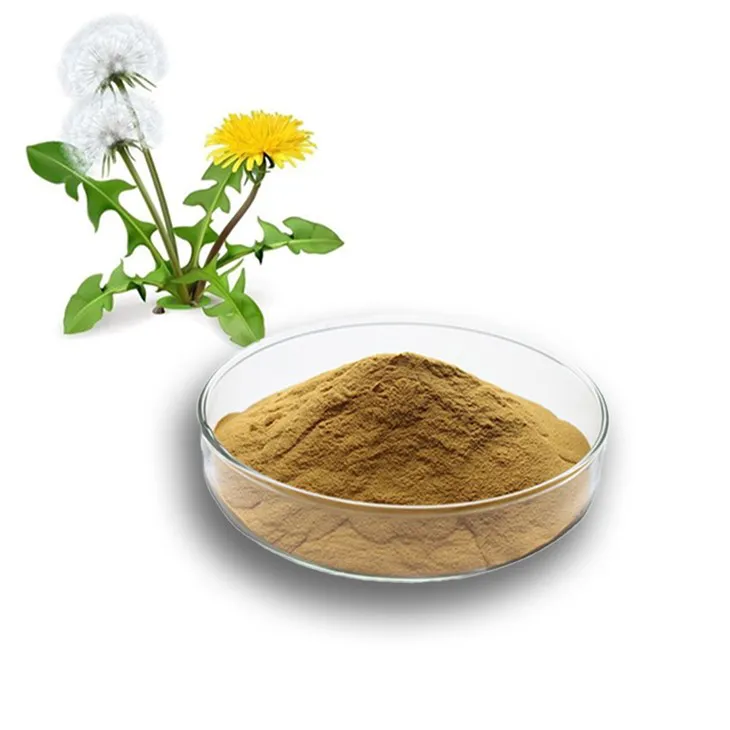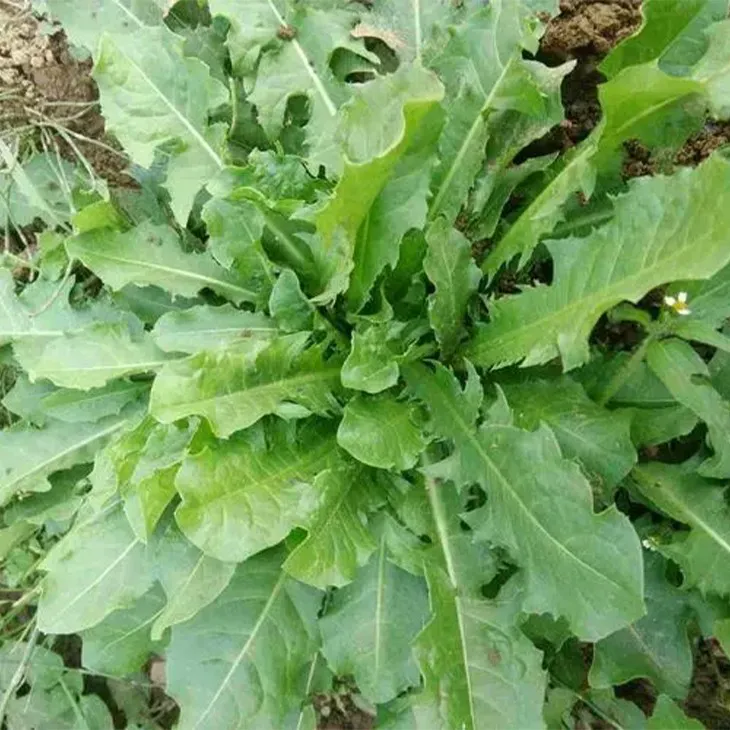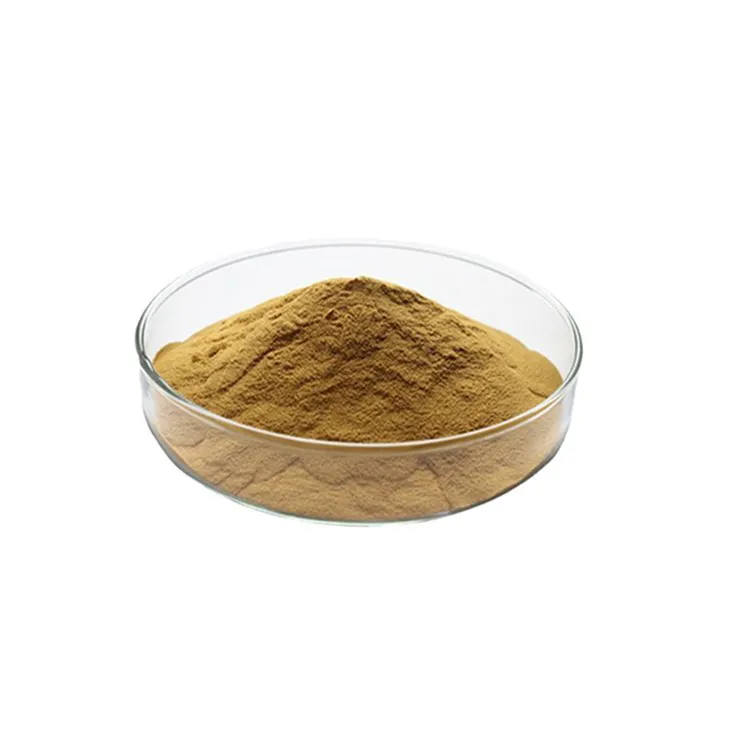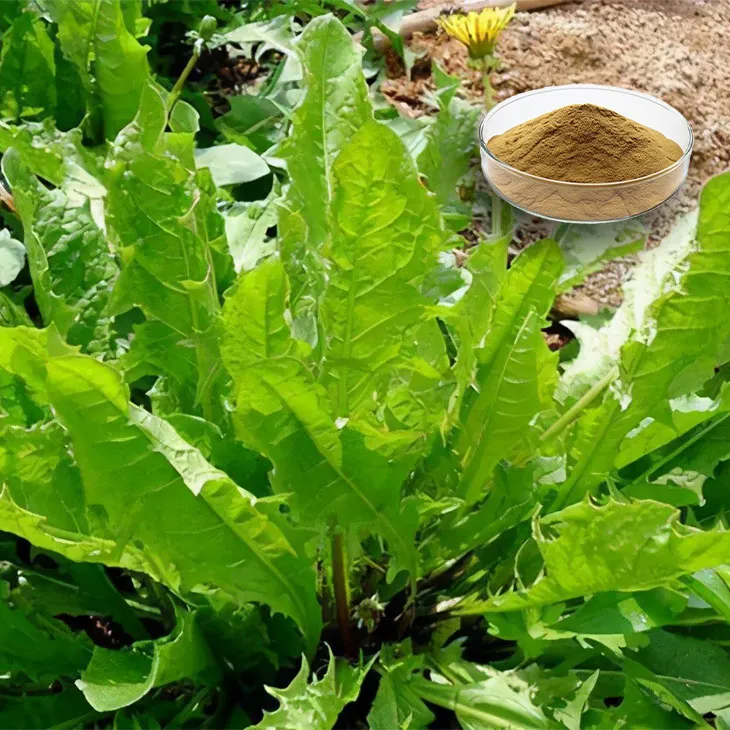- 0086-571-85302990
- sales@greenskybio.com
Dandelion leaf extract: From leaves to extraction.
2024-11-13

1. Introduction
Dandelion (Taraxacum officinale) has long been recognized for its potential health benefits, and its leaves are a valuable source of bioactive compounds. Dandelion Leaf Extract has gained significant attention in various fields, including traditional medicine, pharmaceuticals, and the food industry. Understanding the process of obtaining Dandelion Leaf Extract, from the initial identification and harvesting of the leaves to the extraction techniques, is crucial for ensuring the quality and functionality of the final product.

2. Identification of Dandelion Leaves
2.1. Botanical Characteristics
Dandelion leaves are easily recognizable. They are basal, forming a rosette pattern. The leaves are deeply lobed, typically with irregular, toothed margins. The shape can vary from long and narrow to broader, depending on the growing conditions. The color of the leaves is usually a vibrant green, which can be an indicator of their health and nutrient content.
2.2. Habitat and Growth ConditionsDandelions are highly adaptable plants and can be found in a wide range of habitats. They are often seen in lawns, meadows, and along roadsides. They prefer well - drained soil but can tolerate a variety of soil types, including those with relatively low fertility. Dandelions are also able to grow in both full sun and partial shade, although they tend to be more prolific in sunny locations.

3. Harvesting of Dandelion Leaves
3.1. Timing of Harvest
The timing of the harvest is crucial for obtaining high - quality dandelion leaves. For optimal nutrient and bioactive compound content, it is best to harvest the leaves in the spring or early summer. At this time, the leaves are young and tender, and they contain higher levels of flavonoids, phenolic acids, and other beneficial substances. As the season progresses, the leaves may become tougher and less rich in these valuable components.
3.2. Harvesting MethodsWhen harvesting dandelion leaves, it is important to use clean and sharp tools. Hand - picking is a common method, especially for small - scale harvesting. This allows for the selection of only the healthiest and most suitable leaves. For larger - scale harvesting, mechanical devices can be used, but care must be taken to avoid damage to the leaves and to ensure that only the desired parts of the plant are collected.

4. Traditional Extraction Methods
4.1. Infusion
Infusion is one of the simplest and most traditional methods of extracting compounds from dandelion leaves. This involves steeping the dried or fresh leaves in hot water for a period of time, usually 10 - 15 minutes. The hot water helps to dissolve the water - soluble compounds, such as flavonoids and phenolic acids. The resulting infusion can be used directly as a tea or further processed to obtain a more concentrated extract. One advantage of infusion is that it is a relatively gentle method that preserves many of the heat - sensitive compounds in the leaves. However, it may not be as effective in extracting all of the bioactive components, especially those that are less soluble in water.
4.2. DecoctionDecoction is a more intensive traditional extraction method. In this process, the dandelion leaves are boiled in water for a longer period, typically 30 minutes to an hour. This method is useful for extracting compounds that are more difficult to dissolve, such as some of the polysaccharides and minerals present in the leaves. However, the longer boiling time may cause some degradation of heat - sensitive compounds, potentially reducing the overall quality of the extract.

5. Modern Extraction Techniques
5.1. Solvent Extraction
Solvent extraction is a widely used modern method for obtaining Dandelion Leaf Extract. Different solvents can be used depending on the target compounds. For example, ethanol is often used because it is effective in dissolving a wide range of bioactive substances, including flavonoids and phenolic acids. In solvent extraction, the dandelion leaves are typically ground into a fine powder and then soaked in the solvent for a period of time. The solvent - leaf mixture is then filtered to separate the extract from the solid residue. This method can be more efficient than traditional methods in extracting a greater quantity and variety of compounds, but the choice of solvent must be carefully considered to ensure safety and regulatory compliance.
5.2. Supercritical Fluid ExtractionSupercritical fluid extraction (SFE) is a relatively new and advanced technique. Supercritical fluids, such as carbon dioxide (CO₂) in its supercritical state, are used as solvents. CO₂ in the supercritical state has properties similar to both a gas and a liquid, allowing it to penetrate the plant material easily and selectively extract compounds. SFE has several advantages over traditional solvent extraction. It is a cleaner process, as CO₂ is non - toxic and can be easily removed from the extract, leaving no solvent residue. It also allows for more precise control over the extraction process, resulting in a higher - quality extract with a more consistent composition.
6. Chemical Composition of Dandelion Leaves and its Transfer during Extraction
6.1. Flavonoids
Flavonoids are a major class of bioactive compounds in dandelion leaves. They include substances such as Quercetin, kaempferol, and luteolin. During extraction, the solubility of flavonoids in the chosen solvent or extraction medium plays a crucial role in their transfer from the leaves to the extract. For example, in water - based extractions like infusion, flavonoids with higher water solubility will be more effectively transferred. In solvent extraction, the type of solvent can influence the extraction efficiency of flavonoids. Ethanol - based solvents are often effective in extracting a wide range of flavonoids due to their ability to dissolve both polar and non - polar compounds.
6.2. Phenolic AcidsPhenolic acids, such as caffeic acid and chlorogenic acid, are also important components of dandelion leaves. These compounds are generally more soluble in polar solvents. In extraction processes, their transfer from the leaves to the extract is affected by factors such as the pH of the extraction medium, the temperature, and the contact time. For example, in decoction, the higher temperature and longer extraction time may increase the extraction of phenolic acids, but it may also lead to some degradation if not carefully controlled.
7. Impact of Extraction on the Quality and Composition of the Extract
7.1. Quality Attributes
The extraction method can significantly impact the quality of the dandelion leaf extract. For example, the purity of the extract, which is related to the presence of contaminants and unwanted substances, can be affected. Traditional methods like infusion may introduce fewer contaminants compared to some modern solvent - based methods if the water used is of high quality. However, modern methods such as supercritical fluid extraction can produce a purer extract in terms of removing unwanted plant material and achieving a more concentrated form of the desired compounds.
7.2. Composition ChangesDifferent extraction methods can also lead to changes in the composition of the extract. As mentioned earlier, heat - based methods like decoction may cause the degradation of some heat - sensitive compounds, while solvent extraction may selectively extract certain compounds depending on the solvent used. These composition changes can in turn affect the functionality of the extract in various applications.
8. Functionality of Dandelion Leaf Extract in Different Sectors
8.1. In the Food Industry
Dandelion leaf extract can be used as a natural food additive. It can act as a antioxidant, helping to preserve the freshness and quality of food products. The flavonoids and phenolic acids present in the extract are responsible for its antioxidant properties. Additionally, it can be used to add a unique flavor to food items, such as in herbal teas or in some types of salads.
8.2. In Traditional MedicineIn traditional medicine, dandelion leaf extract has been used for various purposes. It is believed to have diuretic properties, helping to increase urine production and potentially aiding in the elimination of toxins from the body. It may also have anti - inflammatory effects, which could be attributed to the presence of bioactive compounds. However, more scientific research is needed to fully understand and validate these traditional uses.
8.3. In the Pharmaceutical IndustryThe pharmaceutical industry is increasingly interested in dandelion leaf extract due to its potential therapeutic properties. The bioactive compounds in the extract may be studied for their ability to treat certain diseases or conditions, such as diabetes or liver disorders. For example, some studies suggest that the phenolic acids in dandelion leaves may have a role in regulating blood sugar levels.
9. Conclusion
The journey from dandelion leaves to their extract involves multiple steps, from identification and harvesting to extraction using various techniques. The choice of extraction method can have a profound impact on the quality, composition, and functionality of the final extract. Understanding the chemical composition of the leaves and how it is transferred during extraction is essential for optimizing the extraction process and harnessing the full potential of dandelion leaf extract in different sectors. As research continues, new extraction methods and applications for dandelion leaf extract are likely to emerge, further highlighting the importance of this natural resource.
FAQ:
What are the traditional extraction methods for dandelion leaf extract?
Traditional extraction methods for dandelion leaf extract may include maceration and decoction. Maceration involves soaking the dandelion leaves in a solvent (such as ethanol or water) for a period of time to allow the active compounds to dissolve into the solvent. Decoction is a process where the leaves are boiled in water for a certain duration to extract the desired components.
How do modern extraction techniques differ from traditional ones in terms of dandelion leaf extract?
Modern extraction techniques for dandelion leaf extract, such as supercritical fluid extraction or ultrasonic - assisted extraction, often offer more precise control over extraction conditions compared to traditional methods. Supercritical fluid extraction uses substances at their supercritical state as solvents, which can have higher selectivity and efficiency. Ultrasonic - assisted extraction utilizes ultrasonic waves to enhance mass transfer during extraction, usually resulting in shorter extraction times and potentially better preservation of bioactive compounds compared to traditional methods like decoction.
What role do flavonoids play in the functionality of dandelion leaf extract?
Flavonoids in dandelion leaf extract play multiple important roles. They are known for their antioxidant properties, which can help protect cells from oxidative damage. Flavonoids may also contribute to anti - inflammatory effects, making the extract potentially useful in treating inflammatory conditions. Additionally, they can interact with enzymes and receptors in the body, influencing various physiological processes and thereby enhancing the overall functionality of the dandelion leaf extract.
How is the quality of dandelion leaf extract affected by the extraction process?
The extraction process can significantly affect the quality of dandelion leaf extract. The choice of extraction method, extraction time, temperature, and solvent can all influence the composition of the extract. For example, if the extraction temperature is too high or the extraction time is too long, it may lead to the degradation of some heat - sensitive bioactive compounds, reducing the quality of the extract. Also, the type of solvent used can determine which compounds are preferentially extracted, and inappropriate solvents may leave behind important components or introduce impurities.
In which sectors is dandelion leaf extract valuable?
Dandelion leaf extract is valuable in several sectors. In the pharmaceutical industry, due to its potential antioxidant, anti - inflammatory, and other health - promoting properties, it may be used in the development of drugs or dietary supplements. In the cosmetic industry, it can be incorporated into skincare products for its antioxidant and skin - soothing effects. Additionally, in the food and beverage industry, it can be used as a natural flavoring agent or functional ingredient.
Related literature
- Dandelion (Taraxacum officinale) Leaf Extract: Phytochemistry, Pharmacology, and Toxicology"
- "Optimization of Dandelion Leaf Extract Production: A Comprehensive Review"
- "Bioactive Compounds in Dandelion Leaf Extract: Extraction and Applications"
- ▶ Hesperidin
- ▶ Citrus Bioflavonoids
- ▶ Plant Extract
- ▶ lycopene
- ▶ Diosmin
- ▶ Grape seed extract
- ▶ Sea buckthorn Juice Powder
- ▶ Fruit Juice Powder
- ▶ Hops Extract
- ▶ Artichoke Extract
- ▶ Mushroom extract
- ▶ Astaxanthin
- ▶ Green Tea Extract
- ▶ Curcumin
- ▶ Horse Chestnut Extract
- ▶ Other Product
- ▶ Boswellia Serrata Extract
- ▶ Resveratrol
- ▶ Marigold Extract
- ▶ Grape Leaf Extract
- ▶ New Product
- ▶ Aminolevulinic acid
- ▶ Cranberry Extract
- ▶ Red Yeast Rice
- ▶ Red Wine Extract
-
Bilberry Extract
2024-11-13
-
Andrographis Paniculata Extract Powder
2024-11-13
-
melatonin extract
2024-11-13
-
Citrus bioflavonoids
2024-11-13
-
Epimedium extract powder
2024-11-13
-
Jujube Extract
2024-11-13
-
Centella Asiatica Extract
2024-11-13
-
Chaste Berry Extract
2024-11-13
-
Lemon Balm Extract
2024-11-13
-
Garcinia Cambogia Extract
2024-11-13





















